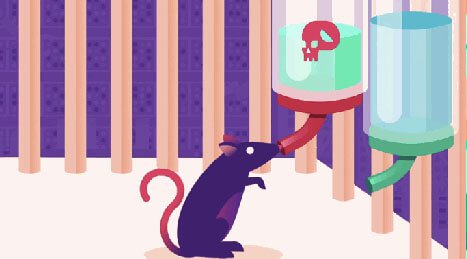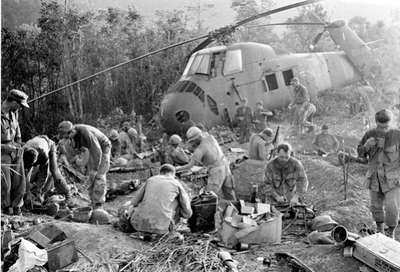Drugs Do the Most Damage when you Can't See a Way Out


Written and verified by the psychologist Gema Sánchez Cuevas
People have tried to explain taking and being addicted to specific substances many ways. They might all be a little bit right. One of the perspectives talks about environmental factors as risk factors for taking and being addicted to a specific drug.
Trying to single out the addictive part of a drug without considering the circumstances and characteristics of the person taking them is a mistake.
To really understand the problem, you have to go beyond the substance. You have to remember its addictive power. You also can’t forget that each person taking it is different.
This leads to questions. For example, why are there people who drink alcohol very often and in large quantities, but don’t become addicted?
The rats that only had drugs and the rats that had an escape chute
You can analyze the phenomenon of addiction better by looking at it in a lab setting. In one experiment there’s a rat in a cage with two bottles of water. One bottle is full of pure water, and the other one has heroine or cocaine mixed in.
Almost every single time they repeated the experiment, the rat would get hooked on the drug-filled water and go back for more until it died.
This makes sense because of the effect drugs have on the brain. But in the 70s, Bruce Alexander, a psychology professor from Vancouver, revised and redesigned the experiment.
This psychologist created a park for the rats (Rat Park). It was a cage full of entertainment where the rats had colorful balls, tunnels to explore, lots of friends, and tons of food.
Basically, it was everything a rat could ever want. All the rats in Rat Park tried the water from both bottles because they didn’t know what was in them.

Then the rats who had a good life didn’t become “prisoners” of the drug. They generally avoided drinking from that bottle. They consumed less than one fourth of the drugs consumed by the isolated rats. Not one died. Meanwhile the rats that were alone and unhappy became addicted and had worse luck.
The first experiment didn’t consider the rat did nothing but wander follow reflections and basic stimuli. It could do that, or it could drink the drugged water, which was at least a new motor activity. That had nothing to do with the attraction of the drugged water to the rat.
The second experiment gives the rats an ALTERNATIVE. The alternative was very attractive, interesting, and reinforcing by itself.
The rats who had an alternative or even just a pleasant routine in their lives didn’t feel any need to keep on drinking the water that stimulated their pleasure. Or at least they didn’t notice the imbalance.
It was even more surprising when someone did a third revision of the experiment. In this one they used rats that had spent 57 days in cages where they could only take the drug.
The researchers observed that once the rats got over withdrawal and were in a happy environment, they all got better.
A good life – the best way not to fall into a bad habit
If you’re happy you won’t need to fill up any empty places. And if you’re unhappy you might try to make up for the missing chemicals with a substance.
The nucleo accumbens is the brain’s dopamine reception center. It also deals with the feelings of pleasure linked to a behavior. This part of our brain is like a king holding court with his environmental and chemical subjects.
There are faithful subjects who bring him goods and services constantly. These subjects are the chemical servants for dopamine: water, food, reinforcing social interaction, a nice bed to sleep in. If these pleasures are lacking, when they come up in a limited, individual way, it means more pleasure.
Thousands of soldiers during the Vietnam War turned into heroin addicts. Once they went back to their homes and got over their withdrawal symptoms, they all picked back up with their normal lives.

Drugs can take a huge amount of control over your behavior. This happens when you lack affection, healthy routines, or a good job. They might turn into an addiction once they have their foot in the door. And they stay around just from repetition and begin to destroy your life.
This is a hopeful explanation that makes sense, with no moralistic or chemically reductionist ideas that paint addicts as people with no character.
It helps us see that addicts might be just like the rats in the first cage: isolated, alone, with only one way out, or one form of pleasure around them.
On the other hand, someone who takes drugs but goes back to a satisfactory environment might avoid falling into addiction. That’s because they’re within reach of a lot of other stimuli that get their brain’s reward systems going.
The key is in making a “cage” that feels free. A “cage” with alternatives you can change around to produce feelings of pleasure. This way you won’t end up creating any dependence on anything.
So drugs are obviously bad. But they’re worse when they’re used in a desperate scenario where the person can’t see any other alternative. Because we all just want to feel good, even if it’s only just for a few seconds.
People have tried to explain taking and being addicted to specific substances many ways. They might all be a little bit right. One of the perspectives talks about environmental factors as risk factors for taking and being addicted to a specific drug.
Trying to single out the addictive part of a drug without considering the circumstances and characteristics of the person taking them is a mistake.
To really understand the problem, you have to go beyond the substance. You have to remember its addictive power. You also can’t forget that each person taking it is different.
This leads to questions. For example, why are there people who drink alcohol very often and in large quantities, but don’t become addicted?
The rats that only had drugs and the rats that had an escape chute
You can analyze the phenomenon of addiction better by looking at it in a lab setting. In one experiment there’s a rat in a cage with two bottles of water. One bottle is full of pure water, and the other one has heroine or cocaine mixed in.
Almost every single time they repeated the experiment, the rat would get hooked on the drug-filled water and go back for more until it died.
This makes sense because of the effect drugs have on the brain. But in the 70s, Bruce Alexander, a psychology professor from Vancouver, revised and redesigned the experiment.
This psychologist created a park for the rats (Rat Park). It was a cage full of entertainment where the rats had colorful balls, tunnels to explore, lots of friends, and tons of food.
Basically, it was everything a rat could ever want. All the rats in Rat Park tried the water from both bottles because they didn’t know what was in them.

Then the rats who had a good life didn’t become “prisoners” of the drug. They generally avoided drinking from that bottle. They consumed less than one fourth of the drugs consumed by the isolated rats. Not one died. Meanwhile the rats that were alone and unhappy became addicted and had worse luck.
The first experiment didn’t consider the rat did nothing but wander follow reflections and basic stimuli. It could do that, or it could drink the drugged water, which was at least a new motor activity. That had nothing to do with the attraction of the drugged water to the rat.
The second experiment gives the rats an ALTERNATIVE. The alternative was very attractive, interesting, and reinforcing by itself.
The rats who had an alternative or even just a pleasant routine in their lives didn’t feel any need to keep on drinking the water that stimulated their pleasure. Or at least they didn’t notice the imbalance.
It was even more surprising when someone did a third revision of the experiment. In this one they used rats that had spent 57 days in cages where they could only take the drug.
The researchers observed that once the rats got over withdrawal and were in a happy environment, they all got better.
A good life – the best way not to fall into a bad habit
If you’re happy you won’t need to fill up any empty places. And if you’re unhappy you might try to make up for the missing chemicals with a substance.
The nucleo accumbens is the brain’s dopamine reception center. It also deals with the feelings of pleasure linked to a behavior. This part of our brain is like a king holding court with his environmental and chemical subjects.
There are faithful subjects who bring him goods and services constantly. These subjects are the chemical servants for dopamine: water, food, reinforcing social interaction, a nice bed to sleep in. If these pleasures are lacking, when they come up in a limited, individual way, it means more pleasure.
Thousands of soldiers during the Vietnam War turned into heroin addicts. Once they went back to their homes and got over their withdrawal symptoms, they all picked back up with their normal lives.

Drugs can take a huge amount of control over your behavior. This happens when you lack affection, healthy routines, or a good job. They might turn into an addiction once they have their foot in the door. And they stay around just from repetition and begin to destroy your life.
This is a hopeful explanation that makes sense, with no moralistic or chemically reductionist ideas that paint addicts as people with no character.
It helps us see that addicts might be just like the rats in the first cage: isolated, alone, with only one way out, or one form of pleasure around them.
On the other hand, someone who takes drugs but goes back to a satisfactory environment might avoid falling into addiction. That’s because they’re within reach of a lot of other stimuli that get their brain’s reward systems going.
The key is in making a “cage” that feels free. A “cage” with alternatives you can change around to produce feelings of pleasure. This way you won’t end up creating any dependence on anything.
So drugs are obviously bad. But they’re worse when they’re used in a desperate scenario where the person can’t see any other alternative. Because we all just want to feel good, even if it’s only just for a few seconds.
This text is provided for informational purposes only and does not replace consultation with a professional. If in doubt, consult your specialist.







